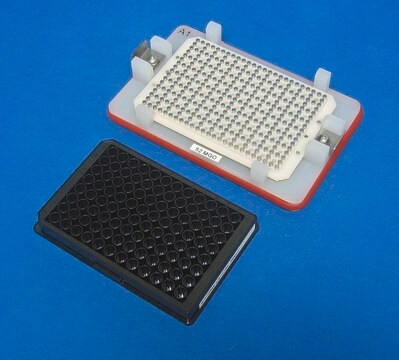HADCYMAG-61K
MILLIPLEX® Human Adipocyte Magnetic Bead Panel - Endocrine Multiplex Assay
The Human Adipocyte Magnetic Bead Panel, using the Luminex xMAP technology, enables the simultaneous analysis of 11 Adipocyte protein biomarkers in cell culture samples.
About This Item
Produtos recomendados
Nível de qualidade
reatividade de espécies
human
fabricante/nome comercial
Milliplex®
assay range
accuracy: 100%
(IL-6)
accuracy: 102%
(TNFα)
accuracy: 103%
(MCP-1)
accuracy: 83%
(PAI-1 (total))
accuracy: 99%
(HGF)
sensitivity: 0.2 pg/mL
(MinDC+2SD; IL-8)
sensitivity: 0.2 pg/mL
(MinDC+2SD; NGF)
sensitivity: 0.2 pg/mL
(MinDC+2SD; TNF?)
sensitivity: 0.6 pg/mL
(MinDC+2SD; IL-6)
sensitivity: 10 pg/mL
(MinDC+2SD; Leptin)
sensitivity: 15 pg/mL
(MinDC+2SD; Adiponectin)
sensitivity: 2.0 pg/mL
(MinDC+2SD; IL-1?)
sensitivity: 2.1 pg/mL
(MinDC+2SD; MCP-1)
sensitivity: 3.0 pg/mL
(MinDC+2SD; HGF)
sensitivity: 4.4 pg/mL
(MinDC+2SD; Resistin)
sensitivity: 4.6 pg/mL
(MinDC+2SD; PAI-1 (total))
standard curve range: 0.29-4,000 pg/mL
(IL-8)
standard curve range: 0.32-5,000 pg/mL
(NGF)
standard curve range: 0.38-6,000 pg/mL
(TNFα)
standard curve range: 0.51-8,000 pg/mL
(IL-1β)
standard curve range: 0.96-150,000 pg/mL
(IL-6)
standard curve range: 0.96-150,000 pg/mL
(MCP-1)
standard curve range: 26-400,000 pg/mL
(Adipnectin)
standard curve range: 6.4-100,000 pg/mL
(HGF)
standard curve range: 6.4-100,000 pg/mL
(Resistin)
standard curve range: 9.6-150,000 pg/mL
(Leptin)
standard curve range: 9.6-150,000 pg/mL
(PAI-1)
inter-assay cv: <15%
intra-assay cv: <10%
(Adiponectin)
inter-assay cv: <15%
intra-assay cv: <10%
(IL-8)
inter-assay cv: <15%
intra-assay cv: <10%
(MCP-1)
inter-assay cv: <15%
intra-assay cv: <10%
(Resistin)
inter-assay cv: <20%
intra-assay cv: <10%
(HGF)
inter-assay cv: <20%
intra-assay cv: <10%
(IL-6)
inter-assay cv: <20%
intra-assay cv: <10%
(NGF)
inter-assay cv: <20%
intra-assay cv: <10%
(PAI-1 (total))
inter-assay cv: <20%
intra-assay cv: <10%
(TNFα)
inter-assay cv: <20%
intra-assay cv: <15%
(IL-1β)
inter-assay cv: <25%
intra-assay cv: <20%
(Leptin)
técnica(s)
multiplexing: suitable
método de detecção
fluorometric (Luminex xMAP)
Condições de expedição
wet ice
Categorias relacionadas
Descrição geral
The MILLIPLEX® Human Adipocyte Panel is an 11-plex kit to be used for the simultaneous quantification of any or all of the following analytes in cell/tissue culture samples: Adiponectin, HGF, IL-β, IL-6, IL-8, Leptin, MCP-1, NGF, PAI-1 (total), Resistin, TNFα. This kit uses a 96-well format, contains a lyophilized standard cocktail, two internal assay quality controls and can measure up to 38 samples in duplicate.
The Luminex® xMAP® platform uses a magnetic bead immunoassay format for ideal speed and sensitivity to quantitate multiple analytes simultaneously, dramatically improving productivity while conserving valuable sample volume.
Panel Type: Metabolism
Especificidade
There was no or negligible cross-reactivity between the antibodies for an analyte and any of the other analytes in this panel.
Aplicação
- Analytes: Adiponectin, HGF, IL-1β, IL-6, IL-8, Leptin, MCP-1, NGF, PAI-1 (Total), Resistin, TNF-α
- Recommended Sample Type: Tissue/cell culture supernatants or extracts
- Recommended Sample Dilution: 25 μL per well of undiluted tissue/cell culture sample; samples may require dilution with an appropriate medium prior to assay
- Assay Run Time: Overnight (16-18 hours) at 2-8°C
- Research Category: Metabolism
- Research Subcategory: Endocrine
Características e benefícios
Embalagem
Armazenamento e estabilidade
Outras notas
Informações legais
Exoneração de responsabilidade
Palavra indicadora
Danger
Frases de perigo
Declarações de precaução
Classificações de perigo
Acute Tox. 3 Dermal - Acute Tox. 4 Inhalation - Acute Tox. 4 Oral - Aquatic Chronic 2 - Skin Sens. 1
Código de classe de armazenamento
6.1C - Combustible acute toxic Cat.3 / toxic compounds or compounds which causing chronic effects
Certificados de análise (COA)
Busque Certificados de análise (COA) digitando o Número do Lote do produto. Os números de lote e remessa podem ser encontrados no rótulo de um produto após a palavra “Lot” ou “Batch”.
Já possui este produto?
Encontre a documentação dos produtos que você adquiriu recentemente na biblioteca de documentos.
Conteúdo relacionado
Multiplex immunoassays, such as MILLIPLEX® multiplex metabolic assays, are critical in metabolic syndrome research because they provide a full picture of the different conditions related to it, like diabetes and obesity, as well as save time and sample volume.
Nossa equipe de cientistas tem experiência em todas as áreas de pesquisa, incluindo Life Sciences, ciência de materiais, síntese química, cromatografia, química analítica e muitas outras.
Entre em contato com a assistência técnica










